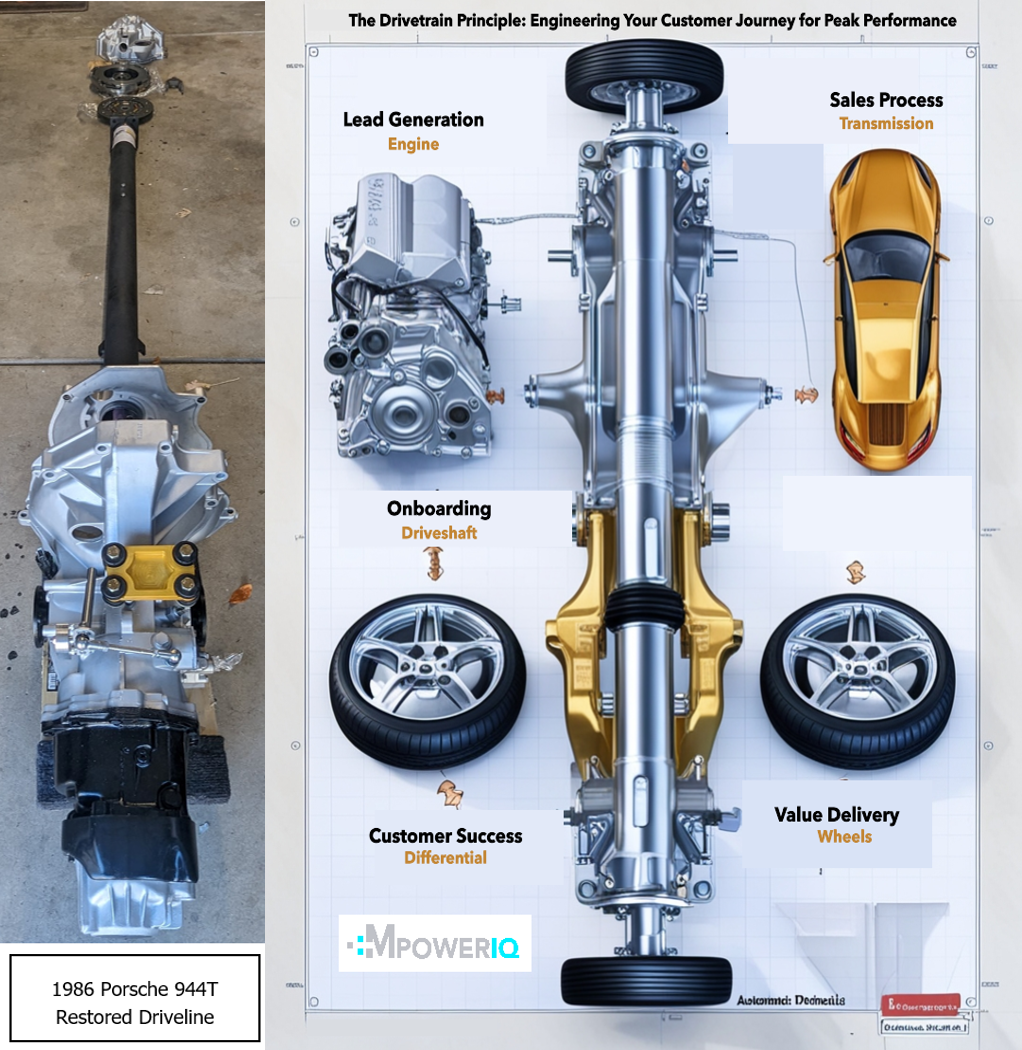🏎️ The Drivetrain Principle: Engineering Your Customer Journey for Peak Performance
Author: Tom Grimaldi
About this project: Those who know me know that I love fixing and restoring just about anything. This particular 1986 Porsche 944 Turbo holds special meaning—it was my dad’s car, bought new and passed along to me. I’ve now embarked on bringing it back to its former glory, applying the same precision and attention to detail that I bring to business transformation. Keep in touch and follow me on this journey as we explore how automotive engineering principles can revolutionize your business approach
As an executive, you’re always looking for ways to optimize your organization’s performance. Today, let’s draw what may seem like an unconventional parallel between a car’s drivetrain and your customer journey—from prospect to contract renewal.
The Power of Precision Engineering Picture a car’s powertrain: energy generated by the engine travels through the transmission and driveshaft, finally reaching the wheels. At each stage, there’s potential for energy loss. A well-engineered system minimizes these losses, ensuring maximum power reaches the road.
The Five Components of Customer Journey Excellence: Your business operates on similar principles, with each component playing a crucial role in delivering value to your customers. Let’s explore how each component drives success:
🔥 Engine (Lead Generation) The engine provides the initial thrust, converting energy into momentum—just like your marketing efforts generate potential energy in the form of leads. A well-tuned engine ensures power flows consistently, driving the rest of the system forward.
The power of this engine comes from the seamless integration of team expertise, cultural values, and enabling technologies. When your marketing team deeply understands your audience needs and embodies organizational values, they create authentic connections that resonate with prospects. AI and LLM tools amplify these efforts by:
- Analyzing behavioral data to identify high-potential opportunities
- Optimizing campaign timing and targeting
- Providing real-time insights that help teams refine their approach
- Automating routine tasks so teams can focus on strategic thinking
However, if the engine sputters—due to poor targeting, low-quality leads, or misaligned campaigns—it places additional strain on the entire system. Success requires a balanced approach where:
- Teams are trained to leverage AI insights effectively
- Cultural values guide decision-making and customer interactions
- Clear processes ensure consistent execution
- Technology enhances rather than replaces human judgment
- Regular feedback loops drive continuous improvement
⚡️ Transmission (Sales Process) The transmission controls how power is applied, adapting to the terrain and speed—just like your sales process needs to flexibly respond to each prospect’s unique journey. The heart of an effective transmission is your sales team’s ability to build authentic relationships and understand customer needs.
Your sales team’s expertise becomes even more powerful when supported by AI-enabled CRM platforms that:
- Provide predictive analytics for better timing
- Offer real-time insights during customer interactions
- Automate follow-up scheduling and task management
- Surface relevant information when needed most
Success in this critical component comes from:
- Ongoing development of customer-centric skills
- A culture of accountability and shared success
- Clear processes for prospect engagement and handoffs
- Technology that enhances personal connections
- Regular refinement based on team feedback
🔄 Driveshaft (Onboarding) The driveshaft transfers power from the transmission to the wheels, ensuring smooth energy flow. Similarly, your onboarding process connects sales handoffs to customer success. This crucial transition depends on your team’s ability to make customers feel valued and supported from day one.
AI and automation tools strengthen this connection by:
- Streamlining administrative tasks
- Providing timely reminders and checkpoints
- Identifying potential friction points early
- Enabling proactive support interventions
The key to smooth power transfer lies in:
- A culture of empathy and customer focus
- Well-defined onboarding procedures
- Teams trained in both technical and soft skills
- Technology that simplifies rather than complicates
- Clear communication channels between departments
💫 Differential (Customer Success) Like a differential distributing power to wheels turning at different speeds, your customer success team must navigate diverse client needs with precision and flexibility. This requires strong relationship-building skills and deep product knowledge.
AI and LLM tools enhance these capabilities by:
- Analyzing customer feedback and sentiment
- Predicting potential challenges before they arise
- Suggesting personalized solutions and approaches
- Automating routine support tasks
Excellence in customer success depends on:
- Strong relationship-building skills
- Proactive problem-solving mindset
- Clear processes for support and escalation
- Technology that augments human insight
- Continuous learning and improvement
🎯 Wheels (Ongoing Value Delivery) Where rubber meets road, ongoing value delivery maintains momentum and customer satisfaction. Your team’s commitment to customer success, supported by clear processes and enabling technologies, ensures consistent delivery of value.
AI tools enhance this delivery by:
- Monitoring key performance indicators
- Identifying opportunities for added value
- Automating routine check-ins and updates
- Providing insights for continuous improvement
Success at this crucial touchpoint requires:
- A culture of continuous improvement
- Regular team training and development
- Clear value delivery processes
- Technology that supports consistency
- Strong feedback loops with customers
🔧 Building Your High-Performance Organization Excellence requires attention to every component while ensuring they work together seamlessly:
- Regular “Tune-ups”: Systematic reviews of processes and performance
- “Performance Parts”: Investment in people, training, and enabling technologies
- “Ongoing Diagnostics”: Robust feedback loops and analysis
- “Smooth Operation”: Cross-functional alignment and collaboration
💡 Key Takeaway Just as drivetrain inefficiencies can significantly reduce a car’s performance, friction in your customer journey can lead to decreased satisfaction, lost renewals, and missed opportunities. Excellence isn’t about any single component—it’s about how well people, processes, and technology work together to deliver exceptional customer experiences.
🚀 Ready to Accelerate? Your customer journey can either be a smooth ride or a bumpy road. Let’s build a high-performance organization that consistently delivers value and leaves the competition behind.

